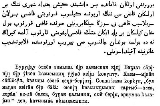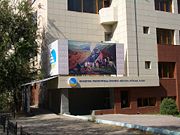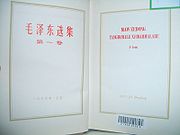
Kazakh alphabet
Encyclopedia
.jpg)
Kazakh language
Kazakh is a Turkic language which belongs to the Kipchak branch of the Turkic languages, closely related to Nogai and Karakalpak....
. The Kazakh language uses the following alphabets:
- The Cyrillic script is officially used in the Republic of KazakhstanKazakhstanKazakhstan , officially the Republic of Kazakhstan, is a transcontinental country in Central Asia and Eastern Europe. Ranked as the ninth largest country in the world, it is also the world's largest landlocked country; its territory of is greater than Western Europe...
and Bayan-Ölgiy ProvinceBayan-Ölgiy ProvinceBayan-Ölgii is the westernmost of the 21 aimags of Mongolia. The aimag was established in 1940. Its capital is Ölgii.- Geography :The aimag is located in the extreme west of the country, and shares borders with both Russia and China...
in MongoliaMongoliaMongolia is a landlocked country in East and Central Asia. It is bordered by Russia to the north and China to the south, east and west. Although Mongolia does not share a border with Kazakhstan, its western-most point is only from Kazakhstan's eastern tip. Ulan Bator, the capital and largest...
. It is also used by native Kazakh populations belonging to the areas of KyrgyzstanKyrgyzstanKyrgyzstan , officially the Kyrgyz Republic is one of the world's six independent Turkic states . Located in Central Asia, landlocked and mountainous, Kyrgyzstan is bordered by Kazakhstan to the north, Uzbekistan to the west, Tajikistan to the southwest and China to the east...
, RussiaRussiaRussia or , officially known as both Russia and the Russian Federation , is a country in northern Eurasia. It is a federal semi-presidential republic, comprising 83 federal subjects...
, TurkmenistanTurkmenistanTurkmenistan , formerly also known as Turkmenia is one of the Turkic states in Central Asia. Until 1991, it was a constituent republic of the Soviet Union, the Turkmen Soviet Socialist Republic . Turkmenistan is one of the six independent Turkic states...
and UzbekistanUzbekistanUzbekistan , officially the Republic of Uzbekistan is a doubly landlocked country in Central Asia and one of the six independent Turkic states. It shares borders with Kazakhstan to the west and to the north, Kyrgyzstan and Tajikistan to the east, and Afghanistan and Turkmenistan to the south....
, as well as diasporas in other countries of the former USSR. It was introduced by the Soviet UnionSoviet UnionThe Soviet Union , officially the Union of Soviet Socialist Republics , was a constitutionally socialist state that existed in Eurasia between 1922 and 1991....
in 1940. - The Arabic script is officially used in People's Republic of ChinaPeople's Republic of ChinaChina , officially the People's Republic of China , is the most populous country in the world, with over 1.3 billion citizens. Located in East Asia, the country covers approximately 9.6 million square kilometres...
in the Altay PrefectureAltay PrefectureAltay Prefecture is located in northern Xinjiang, China. It has an area of 118,015 km² and a population of 561,667 . It is a part of Ili Kazakh Autonomous Prefecture...
and the Ili Kazakh Autonomous PrefectureIli Kazakh Autonomous PrefectureIli Kazakh Autonomous Prefecture , in northernmost Xinjiang, is the only Kazakh autonomous prefecture of the People's Republic of China.-Geography and coordinates:The following figures excludes both Tacheng Prefecture and Altay Prefecture....
of the Xinjiang Uyghur Autonomous Region. It is also used in IranIranIran , officially the Islamic Republic of Iran , is a country in Southern and Western Asia. The name "Iran" has been in use natively since the Sassanian era and came into use internationally in 1935, before which the country was known to the Western world as Persia...
and AfghanistanAfghanistanAfghanistan , officially the Islamic Republic of Afghanistan, is a landlocked country located in the centre of Asia, forming South Asia, Central Asia and the Middle East. With a population of about 29 million, it has an area of , making it the 42nd most populous and 41st largest nation in the world...
. This is a modified script based on the alphabet used for Kazakh before 1927. - A Latin alphabet based on the Turkish alphabetTurkish alphabetThe Turkish alphabet is a Latin alphabet used for writing the Turkish language, consisting of 29 letters, seven of which have been modified from their Latin originals for the phonetic requirements of the language. This alphabet represents modern Turkish pronunciation with a high degree of accuracy...
is unofficially used by the Kazakh diaspora in TurkeyTurkeyTurkey , known officially as the Republic of Turkey , is a Eurasian country located in Western Asia and in East Thrace in Southeastern Europe...
. The Kazakh diaspora also uses a surrogate Latin alphabet in GermanyGermanyGermany , officially the Federal Republic of Germany , is a federal parliamentary republic in Europe. The country consists of 16 states while the capital and largest city is Berlin. Germany covers an area of 357,021 km2 and has a largely temperate seasonal climate...
, the USUnited StatesThe United States of America is a federal constitutional republic comprising fifty states and a federal district...
and in other Western countries. As with other Central Asian Turkic languagesTurkic languagesThe Turkic languages constitute a language family of at least thirty five languages, spoken by Turkic peoples across a vast area from Eastern Europe and the Mediterranean to Siberia and Western China, and are considered to be part of the proposed Altaic language family.Turkic languages are spoken...
, a Latin alphabet was introduced by the Soviets and used from 1927 to 1940 when it was replaced with Cyrillic.
Cyrillic script

Ibrahim Altynsarin
Ibrahim Altynsarin was a major figure in pre-Soviet Kazakh history...
, a prominent Kazakh educator, first introduced a Cyrillic alphabet for transcribing Kazakh. Russian missionary activity, as well as Russian-sponsored schools, further encouraged the use of Cyrillic in the nineteenth and early twentieth centuries. The alphabet was reworked by Sarsen Amanzholov
Sarsen Amanzholov
Sarsen Amanzholovich Amanzholov , was a famous Turkologist, and one of the pioneers of Kazakh linguistics. He cultivated the foundations of Kazakh grammar for all levels of education, and helped create the current Cyrillic Kazakh alphabet...
and accepted in its current form in 1940. It contains 42 letters: 33 from the Russian alphabet with 9 additional letters for sounds of the Kazakh language: Ә, Ғ, Қ, Ң, Ө, Ұ, Ү, Һ, І; until 1957 was used instead of Ұ). Initially, Kazakh letters came after letters from the Russian alphabet, but now they are placed after Russian letters similar in sound or shape.
The letters В, Ё (since 1957), Ф, Х, Һ, Ц, Ч, Щ, Ъ, Ь and Э are not used in native Kazakh words. Of these, Ё, Ц, Ч, Щ, Ъ, Ь, Э, are used only in words borrowed from Russian or through the Russian language which are written according to Russian orthographic rules. The letter Х in conversational speech is pronounced similar to Қ. The letter Һ is used only in Arabic-Persian borrowings and is often pronounced like an unvoiced Х.
The letter И represents the tense vowel [i] obtained from the combinations ЫЙ /əj/ and ІЙ /ɪj/. The letter У represents /w/ and the tense vowel [u] obtained from the combinations ҰУ /ʊw/, ҮУ /ʉw/, ЫУ /əw/ and ІУ /ɪw/.
Encoding
Before the spread of operating systems and text editors with support forUnicode
Unicode
Unicode is a computing industry standard for the consistent encoding, representation and handling of text expressed in most of the world's writing systems...
, Cyrillic Kazakh often didn't fit on a keyboard because of the problem with 8-bit encoding, which was not supported at the system level and the absence of standard computer fonts. More than 20 variations of 8-bit encoding for Kazakh Cyrillic have been suggested, including the following government standards:
(Note these are historical code pages, modern systems use Unicode Encoding, such as UTF-8)
- CT PK 920-91 for DOS (a modification of code pageCode pageCode page is another term for character encoding. It consists of a table of values that describes the character set for a particular language. The term code page originated from IBM's EBCDIC-based mainframe systems, but many vendors use this term including Microsoft, SAP, and Oracle Corporation...
866) - CT PK 1048—2002 for Windows (a modification of code page 1251)
CT PK 1048—2002 was confirmed in 2002, well after the introduction of different Windows character sets. Some Internet resources in part used the government information agency "KazAkparat" before the encoding of this standard. Today the encoding UTF-8 is being accepted.
Keyboard
The standard Windows keyboard layoutKeyboard layout
A keyboard layout is any specific mechanical, visual, or functional arrangement of the keys, legends, or key–meaning associations of a computer, typewriter, or other typographic keyboard....
used for Cyrillic Kazakh in Kazakhstan is a modification of the standard Russian keyboard, with characters found in Kazakh but not in Russian located on the number keys.

Arabic
The Arabic script is still the official alphabet for Kazakhs in the People's Republic of ChinaPeople's Republic of China
China , officially the People's Republic of China , is the most populous country in the world, with over 1.3 billion citizens. Located in East Asia, the country covers approximately 9.6 million square kilometres...
. It was first introduced to the territory of Kazakhstan in the eleventh century, and was traditionally used to write Kazakh until the introduction of a Latin alphabet in 1927. In 1924, Kazakh intellectual Akhmet Baitursynov
Akhmet Baitursynov
Akhmet Baytursinuli was a Kazakh intellectual who worked in the fields of poetry, linguistics and education.Baytursinuli was born in what is today Kostanay Province, and was educated at the Orenburg Teachers' School...
attempted to reform the Arabic script to better suit Kazakh. The letters چ، پ، ڭ، گ، ۆ are used to represent sounds not found in the Arabic language
Arabic language
Arabic is a name applied to the descendants of the Classical Arabic language of the 6th century AD, used most prominently in the Quran, the Islamic Holy Book...
.
Latin

Uniform Turkic Alphabet
The Uniform Turkic Alphabet was a Latin alphabet used by non-Slavic peoples of the USSR in the 1930s. The alphabet used ligatures from Jaŋalif as it was also a part of the uniform alphabet. The uniform alphabet utilized Latin ligatures, excluding "w." Some additional ligatures were also introduced...
was used in the USSR from 1927 to 1940, when it was replaced by the current Cyrillic script. Kazakh speakers in countries that use the Latin script also use a different Latin alphabet based on the Turkish alphabet
Turkish alphabet
The Turkish alphabet is a Latin alphabet used for writing the Turkish language, consisting of 29 letters, seven of which have been modified from their Latin originals for the phonetic requirements of the language. This alphabet represents modern Turkish pronunciation with a high degree of accuracy...
.

People's Republic of China
China , officially the People's Republic of China , is the most populous country in the world, with over 1.3 billion citizens. Located in East Asia, the country covers approximately 9.6 million square kilometres...
in 1964-84. Later, the use of the Kazakh Arabic alphabet was restored in China.
Recently as part of a modernization program the government has stated plans for replacing Cyrillic with Latin officially. As of 2007, the costs and consequences of such a move are being investigated.
Some websites of the government of Kazakhstan are available in both Latin and Cyrillic scripts. Among them are http://www.government.kz/, the main government website, and National information agency Kazinform (also known as QazAqparat).
On December 13, 2007, Kazakhstan's President Nursultan Nazarbayev offered not to advance the transformation of the Kazakh alphabet from the Cyrillic to Latin one, as he noted: "For 70 years, the Kazakhstanis read and wrote in Cyrillic. More than 100 nationalities live in our state. Thus we need stability and peace. We should be in no hurry in the issue of alphabet transformation".
Correspondence chart
Correspondence chart of official and most widespread writing scripts| Cyrillic | Latin (by QazAqparat) | Arabic | Name of Arabic Letter | IPA transcription |
|---|---|---|---|---|
| А а | A a | ا | Alif | /ɑ/ |
| Ә ә | Ä ä | ٵ | Hamza + Alif | /æ/ |
| Б б | B b | ب | Ba | /b/ |
| В в | V v | ۆ | Waw with V | /v/ |
| Г г | G g | گ | Gaf | /ɡ/ |
| Ғ ғ | Ğ ğ | ع | Ghain | /ʁ/ |
| Д д | D d | د | Dal | /d/ |
| Е е | E e | ه | Ha | /e/ |
| Ё ё | Yo yo | يو | Yo | /jo/ |
| Ж ж | J j | ج | Jeem | /ʒ/ |
| З з | Z z | ز | Za | /z/ |
| И и | Ï ï | ٸ | Ya | /ɯj/, /ɪj/ |
| Й й | Y y | ي | Ya | /j/ |
| К к | K k | ك | Kaf | /k/ |
| Қ қ | Q q | ق | Qaf | /q/ |
| Л л | L l | ل | Lam | /l/ |
| М м | M m | م | Meem | /m/ |
| Н н | N n | ن | Noon | /n/ |
| Ң ң | Ñ ñ | ڭ | Kaf with 3 dots | /ŋ/ |
| О о | O o | و | Waw | /o/ |
| Ө ө | Ö ö | ٶ | Hamza + Waw | /ø/ |
| П п | P p | پ | Pa | /p/ |
| Р р | R r | ر | Ra | /r/ |
| С с | S s | س | Seen | /s/ |
| Т т | T t | ت | Ta | /t/ |
| У у | W w | ۋ | Waw with 3 dots | /w/, /ʊw/, /ʉw/ |
| Ұ ұ | U u | وُ | Waw with damma | /ʊ/ |
| Ү ү | Ü ü | ٶُ | Hamza + Waw with damma | /ʉ/ |
| Ф ф | F f | ف | Fa | /f/ |
| Х х | X x | ح | Kha without dots | /x, χ/ |
| Һ һ | H h | ھ | Initial Ha | /h/ |
| Ц ц | C c | تس | T + S | /ts/ |
| Ч ч | Ç ç | چ | Cheem | /tʃ/ |
| Ш ш | Ş ş | ش | Sheen | /ʃ/ |
| Щ щ | Şş şş | شش | Sh + Sh | /ʃtʃ/, /ʃː/ |
| Ъ ъ | -- | -- | -- | |
| Ы ы | I ı | ى | Ya without dots | /ɯ/ |
| І і | İ i | ٴى | Hamza + Ya without dots | /ɪ/ |
| Ь ь | -- | -- | -- | |
| Э э | Ee (Éé) | ه | Ha | /e/ |
| Ю ю | Yu yu | يۋ | Y + U | /jʉw/, /jʊw/ |
| Я я | Ya ya | يا | Y + A | /jɑ/ |
Symbols in parentheses are for bi-directional transliteration only.
Text sample
Article 1 of the Universal Declaration of Human RightsUniversal Declaration of Human Rights
The Universal Declaration of Human Rights is a declaration adopted by the United Nations General Assembly . The Declaration arose directly from the experience of the Second World War and represents the first global expression of rights to which all human beings are inherently entitled...
| Kazakh in Cyrillic script |
Kazakh in Arabic script |
Kazakh in Latin script |
English |
| Барлық адамдар тумысынан азат және қадір-қасиеті мен кұқықтары тең болып дүниеге келеді. Адамдарға ақыл-парасат, ар-ождан берілген, сондықтан олар бір-бірімен туыстық, бауырмалдық қарым-қатынас жасаулары тиіс. | Barlıq adamdar twmısınan azat jäne qadir-qasïeti men quqıqtarı teñ bolıp dünïege keledi. Adamdarğa aqıl-parasat, ar-ojdan berilgen, sondıqtan olar bir-birimen twıstıq, bawırmaldıq qarım-qatınas jasawları tïis. | All human beings are born free and equal in dignity and rights. They are endowed with reason and conscience and should act towards one another in a spirit of brotherhood. |

